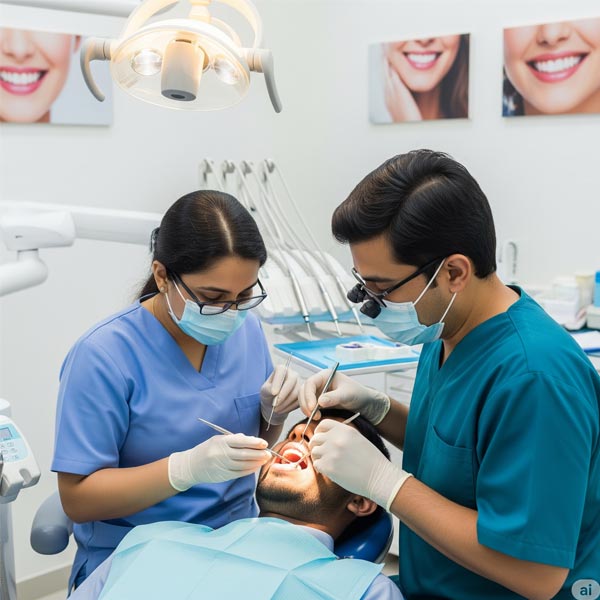What is a cracked tooth?
A cracked tooth is when something damages your tooth and causes a small break (crack or fracture) in it. The crack may be small enough that it doesn’t affect your tooth. Other times, your tooth may break in pieces or split. A badly cracked tooth may be a dental emergency.
Types of cracked teeth
Your dentist will classify your tooth fracture as one of the following five categories:
Cracked tooth: This is a vertical crack that runs from the biting surface of your tooth up to your gum line. Sometimes, the crack extends into your gum line and root.
Split tooth: As the name implies, this is when a crack splits your tooth into two parts. A split tooth may run below your gum line.
Vertical root fracture: This is a crack that starts below your gum line and moves toward the surface of your tooth. This type of cracked tooth may not cause symptoms unless your tooth pulp becomes infected.
Is a cracked tooth a serious injury?
It can be. For example, a crack in your tooth opens the door for bacteria to seep into your tooth pulp and cause a tooth abscess. Left untreated, a tooth abscess may spread to your jawbone. It may also spread to your facial muscles, tendons and fat cells in your face and neck.
Symptoms and Causes
Cracked teeth don’t always cause symptoms. When they do, the main symptoms include: Sharp pain when you bite down on a tooth.
- Sensitivity to temperature changes or eating sweet foods.
- Swelling around the tooth.
- Toothache when biting or chewing.
- Swollen gums and lymphnodes , fever may occur
What causes cracked teeth?
Age: Your teeth wear down as you get older, increasing the chance you’ll crack a tooth.
Dental treatments: Treatments like a large dental filling or a root canal.
Bruxism (teeth grinding): Stress and other issues may make you grind your teeth and, over time, crack a tooth.
Dental trauma: You can crack a tooth if you’re hit in the mouth. That can happen if you fall, get hurt while playing sports or if you’re in a vehicle accident.
Diagnosis and Tests
- To diagnose a fractured tooth, a dentist will ask about your symptoms and possible causes.
- Check your tooth for signs of cracks and other damage.
- Examine your gums for inflammation, since vertical fractures may irritate your gums.
- Take dental X-rays to see fractures and related issues, such as bone loss. Imaging may include a 3D scan called a cone beam CT (computed tomography) scan that can show bone loss that may be a sign of a fracture.
- Use a periodontal probe to help find the crack. A periodontal probe is a tiny tool that measures bone loss around your tooth.
- Your dentist may refer you to an endodontist (root canal specialist) for more or different treatment. An endodontist is a dental specialist who focuses on treating issues with dental pulp and roots
Management and Treatment
- Dental bonding: A provider fills in cracks with tooth-colored resin.
- Dental crown: A provider fits a porcelain or ceramic cap over the cracked tooth.
- Dental veneers: These are custom-made shells that fit over the front of your tooth. The shells may be porcelain or plastic.
- Root canal: A cracked tooth that goes down into your tooth pulp can lead to infection. A provider may do a root canal to remove infected pulp.
- Tooth extraction: If a crack in your tooth does severe damage to the root and nerves, your dentist may recommend removing your tooth. They may replace your tooth with a dental bridge or dental implant
Can I fix a cracked tooth at home?
No, you can’t. You should always talk to a dentist if you suspect you have a cracked tooth. But there are ways to ease your symptoms before your appointment:
Protect your mouth and teeth: Wear a mouth guard if you play contact sports where there’s a chance you’ll be hit in your mouth, like football, basketball or hockey.
Don’t chew hard things: That includes chewing on ice, hard candy and your fingernails .And don’t use your teeth to rip off plastic tags or tough plastic wrapping.
Enamel Fracture
Treatment options depend on fragment availability and the extent of the lesion. The tooth fragment may be reattached, the edges may be smoothed, and the defect may be restored.
Enamel-Dentin Fracture
Exposed dentinal tubules must be sealed with a bonding agent and restored with composite resin or glass ionomer. calcium hydroxide may be used as a lining material before placing a glass ionomer cement restoration, if dentin is close to pulp.
Enamel-Dentin Fracture with Pulp Exposure
A conservative approach is preferred, as teeth can form a dentinal bridge after pulp exposure when treated with a pulp-capping material.
Pulp capping
Also known as direct pulp protection, pulp capping involves applying a material with regenerative properties, commonly calcium hydroxide, to small pulp exposures. This technique is indicated when the pulp has been exposed for a short duration.
Partial pulpotomy
Partial pulpotomy involves amputating the pulp 2 mm below the exposure site, where the tissue is presumed to be healthy Restorative options include freehand or indirect composite resin restoration, fragment reattachment if available, and ceramic restoration.
Crown-Root Fractures
Management begins with removing the tooth fragment to assess the full extent of the fracture and pulp involvement. If conditions allow, the fragment may be reattached later. If the pulp remains unexposed, the exposed dentin can be covered with glass ionomer or composite resin after retrieving the fragment.
Root Fractures
Initial management of root fractures involves repositioning the displaced crown fragment and confirming proper alignment with an x-ray. Endodontic treatment should not be performed during the emergency appointment.






